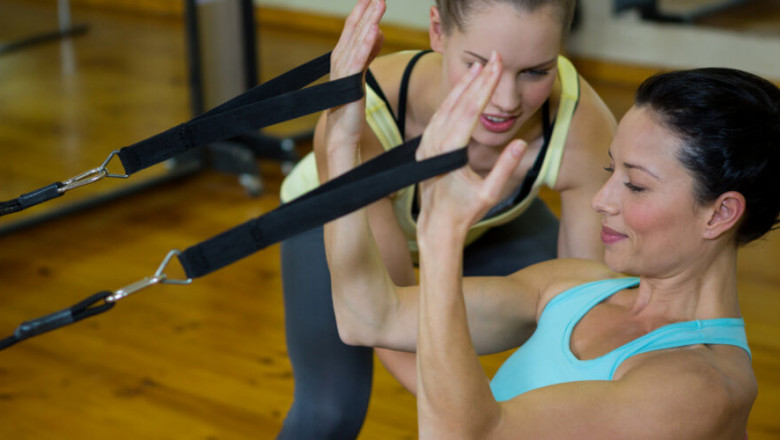views

Pilates has been in trend for the last few years, but Joseph Pilates developed it during World War I. However, pilates has evolved a lot, and at present, it’s not just a rehabilitation strategy.
According to a survey, over 12 million people are enjoying pilates as a fitness regime. One of the critical factors of the popularity of this regime is that almost anyone can perform it. It puts minimum stress on the joints avoiding any severe injury.
If you have an experienced pilates instructor with skills in physical therapy, workout science, and body mechanics, you can leverage numerous benefits from the program. But, what else does it offer to an individual, and what exactly is a pilates program? We’ll discuss everything in this article.
What is Pilates?
Pilates is a set of exercises that focuses on flexibility, mobility, balance, and posture. You can perform it on a mat or a reformer, and it offers benefits like physical stability and mental well-being.
Pilates is the first choice for a fitness regime, injury prevention, and rehabilitation. The exercises in Pilates are extremely helpful in improving strength, endurance, and control. It helps you enhance several skills.
Pilates exercises concentrate on core strength, limb flexibility, and overall strength, which helps stabilize the body.
How can Pilates Save You From An Injury?
Although physical therapists widely use pilates for rehabilitation purposes, it is also helpful in injury prevention. However, no exercise can always guard you against injuries. Thus, pilates is not a magic trick to stay away from getting injured.
However, these exercises are developed so that they eliminate the risk of getting injured by some percentage. As your strength shoots up and the improvement in balance eventually leads to injury prevention.
There’s also a positive impact on bone density and range of motion. All these factors combine to give an overall strong body posture which minimizes the risk of injury.
What Kind Of Injuries can be Recovered from Pilates?
An injury is caused mainly due to excessive pressure on the tissues or joints. Pilates can save you from getting injured, and it is effective for the following types of injuries:
-
Back Pain: The improvement of flexibility and strength of the spine results in a better range of motion.
-
Knee Damage: Knee injuries are often a byproduct of weak core or glutes. Pilates strengthens these muscle groups, which eliminates any knee injury risk.
-
Stroke Issues: Stroke can cause damage to the inner body resulting in a stationary lifestyle. Pilates rehabilitation counters all these issues, making the movements easy for stroke patients.
Few other notable injuries which pilates can treat:
-
Scoliosis
-
Meniscus tear
-
Joint replacement surgery
-
Shoulder Injuries
-
Disc Slip
Rehabilitative Benefits of Pilates
1. Fix Spinal Curvatures and Disease
Distorted posture can be harmful to the health of tendons and muscles in the back or shoulders. Bad posture can lead to incorrect movements, which then result in injury.
Pilates, thus, is an incredible option for people who sit for a prolonged period. It also helps in fixing the spinal curvature along with spinal issues or scoliosis.
If you strengthen your back and shoulders, it can help you maintain a good posture which takes off the excess pressure from the spine.
2. Strengthen the Core
As discussed in the last point, pilates exercises are an excellent option to strengthen the core muscle groups. Core muscles work like a bridge between the upper body & lower body. It stabilizes the body and helps in almost every motor skill like running, jumping, etc.
Core strength gives freedom to the muscle groups so that they can perform the movements without any hurdle. The strength activates the muscle groups, and it prevents injuries like disc herniation.
3. Learn Rehabilitation Techniques
One of the most crucial aspects of pilates is rehabilitation. The recovery process by physical therapy contains several exercises which can be a bit tough to perform.
Pilates focuses on the range of motion, body positioning, and muscle alignment while performing these exercises. Improper form can impact the recovery process, making it difficult for the patient.
4. Increases Flexibility
Apart from exercises, the pilates regimen contains a lot of dynamic and static stretching. Stretching is crucial for both warm-up and flexibility.
Flexibility is interlinked with a range of motion which is essential for any movement. Pilates is, therefore, an excellent way to counter stiffness by increasing the flexibility of an individual.
5. Rehabilitation for Slip Disc
If you ever had a herniated disc or slipped disc, then pilates can restore the damage. Pilates helps in stabilizing the muscle groups in the neck and back region. Stabilization gives better support which can prevent such issues.
Pilates can take excess pressure off the back, making it less vulnerable to slipped or herniated discs.
Conclusion
In the end, pilates is an excellent alternative of exercises for older adults and people with injuries. It can also help you to perform more complex physical movements. Thus, if you’re on the journey of rehabilitation, there’s no better tool than a pilates fitness regime.












